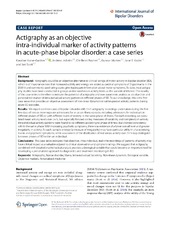| dc.contributor.author | Krane-Gartiser, Karoline | en_US |
| dc.contributor.author | Asheim, Andreas | en_US |
| dc.contributor.author | Fasmer, Ole Bernt | en_US |
| dc.contributor.author | Morken, Gunnar | en_US |
| dc.contributor.author | Vaaler, Arne | en_US |
| dc.contributor.author | Scott, Janine Linda | en_US |
| dc.date.accessioned | 2018-08-24T08:50:16Z | |
| dc.date.available | 2018-08-24T08:50:16Z | |
| dc.date.issued | 2018-03-07 | |
| dc.Published | Krane-Gartiser K, Asheim A, Fasmer OB, Morken G, Vaaler A, Scott JL. Actigraphy as an objective intra‑individual marker of activity patterns in acute‑phase bipolar disorder: a case series. International journal of bipolar disorders. 2018;6:8 | eng |
| dc.identifier.issn | 2194-7511 | |
| dc.identifier.uri | https://hdl.handle.net/1956/18222 | |
| dc.description.abstract | Background: Actigraphy could be an objective alternative to clinical ratings of motor activity in bipolar disorder (BD), which is of importance now that increased activity and energy are added as cardinal symptoms of (hypo)mania in the DSM-5 and commonly used rating scales give inadequate information about motor symptoms. To date, most actigraphy studies have been conducted in groups and/or used mean activity levels as the variable of interest. The novelty of this case series is therefore to indicate the potential of actigraphy and non-parametric analysis as an objective and personalized marker of intra-individual activity patterns in different phases of BD. To our knowledge, this is the first case series that provides an objective assessment of non-linear dynamics in within-person activity patterns during acute BD episodes. Results: We report on three cases of bipolar I disorder with 24-h actigraphy recordings undertaken during the first few days of two or more separate admissions for an acute illness episode, including admissions for individuals in different phases of BD, or with different levels of severity in the same phase of illness. For each recording, we calculated mean activity levels over 24 h, but especially focused on key measures of variability and complexity in activity. Intra-individual activity patterns were found to be different according to phase of illness, but showed consistency within the same phase. With increasing psychotic symptoms, there was evidence of a lower overall level and greater irregularity in activity. As such, sample entropy (a measure of irregularity) may have particular utility in characterizing mania and psychotic symptoms, while assessment of the distribution of rest versus activity over 24 h may distinguish between phases of BD within an individual. Conclusions: This case series indicates that objective, intra-individual, real-time recordings of patterns of activity may have clinical impact as a valuable adjunct to clinical observation and symptom ratings. We suggest that actigraphy combined with detailed mathematical analysis provides a biological variable that could become an important tool for developing a personalized approach to diagnostics and treatment monitoring in BD. | en_US |
| dc.language.iso | eng | eng |
| dc.publisher | Springer | eng |
| dc.rights | Attribution CC BY | eng |
| dc.rights.uri | http://creativecommons.org/licenses/by/4.0 | eng |
| dc.subject | Actigraphy | eng |
| dc.subject | Bipolar disorder | eng |
| dc.subject | Mania | eng |
| dc.subject | Intra-individual | eng |
| dc.subject | Variability | eng |
| dc.subject | Non-linear dynamics | eng |
| dc.subject | Biological variable | eng |
| dc.subject | Objective markers | eng |
| dc.subject | Personalized medicine | eng |
| dc.title | Actigraphy as an objective intra‑individual marker of activity patterns in acute‑phase bipolar disorder: a case series | en_US |
| dc.type | Peer reviewed | |
| dc.type | Journal article | |
| dc.date.updated | 2018-03-07T09:51:42Z | |
| dc.description.version | publishedVersion | en_US |
| dc.rights.holder | Copyright 2018 The Author(s) | |
| dc.identifier.doi | https://doi.org/10.1186/s40345-017-0115-3 | |
| dc.identifier.cristin | 1571048 | |
| dc.source.journal | International journal of bipolar disorders | |

